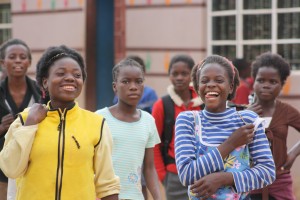Northern Spirit (From Whitehorse)
Dec 10th, 2009 by nhart

This documentary video starts with a young woman’s narration of a legend through what looks like a shadow puppet show. The video goes on to ask, “How has the spirituality of young women changed?” It features women sharing their thoughts and experiences to do with spirituality and their encounters with traditional indigenous knowledge. The women talk, among other things, about the gap between traditional knowledge of spirituality and language, and their present day access to such knowledge. The video was created by a group of young women who participated in a workshop through the non-profit organization I am concentrating on – Girls Action Foundation – Fondation filles d’action (based out of Montreal, Quebec) with the organization’s facilitation. According the Kickaction* (part of Girls Action) website, “This inspiring video was created by a group of young women at the Make Some Noise North training that took place in Whitehorse [Yukon] in July” (n.d.)
The production is a representation from the metaphorical ‘Global South’ – while it is located in the ‘Global North,’ it features the Yukon, an area in Canada which has not been as great a focus in the country, and where it is my impression that resources are not always as readily available. It also films people from ‘groups’ which have historically been oppressed – young women and members of indigenous communities. I feel cautious to label the speakers as ‘subaltern’ though – although they may not have not been allowed enough of a voice, I do not want to portray them as victims. (While I do not think Sharp’s (2008) article, “Can the Subaltern Speak” attempts to portray the subaltern purely as victims, the term still carries the danger of the connotation.) Conversely, I like the fact that the video showcases the women’s strengths (for example through their video production skills) and the insights they have to offer on their upbringing and community.
The video also addresses the problem of “epistemic violence” discussed in Sharp’s article, “Can the Subaltern Speak?” (Spivak, cited in Sharp, 2008, p. 111) Sharp writes, “the term ‘epistemic violence‘ … refers to violence done to the ways of knowing and understanding of non-western, indigenous peoples” (Spivak, cited in Sharp, 2008, p. 111). In the video, one of the young women talks about the fact that a lot of the spirituality has been lost for women in today’s society due to intergenerational abuses from the residential school era. According to my own understanding, the residential school system broke the link between indigenous people and various forms of traditional knowledge through a few means: By removing children from their families, imposing a different language (English) and religion (Christianity) on them, and perpetuating such cruelties – physical, sexual and emotional abuse – which created significant trauma in their communities, making it difficult for them to connect to their past. The cited woman may also have been referring to the abuses within their community which resulted from the cruelties perpetuated within the residential school era. Her reference to the point that knowledge has been lost is also illustrated by one of the other young women in the video, when she says that when an elder asks a student in their indigenous language to bring them kleenex, they come back with a pen and a bowl instead of kleenex. As she says, “We are losing it nowadays.”
Girls Action Foundation could be said to allow more than one ‘cross-section’ within the subaltern to ‘speak.’ They encourage girls and young women, who even in the ‘West’ (in this case Canada) have historically been disenfranchised, to share their experiences and views. They also seek to empower the voices of girls and young women who have typically been marginalized, and have not seen themselves represented through role models: for example girls and women of colour, of minority groups, various sexual orientations and gender identities, socioeconomic backgrounds, less enfranchised geographic regions of Canada, and so on. However, watching this video brings to light the question of whether, symbolically, the privileged are ’empowering’ the less powerful: Koopman’s (2008) article, “Imperialism Within” raises the point that women in positions of power (white middle class women) have often historically been in ‘helping’ roles (p. 1). Girls Action has a lot of diversity within their workplace, however I still wonder whether this dynamic takes form: is it the ‘privileged’ people (with education and status) showing others (who may or may not have less privilege) how to create video productions, and share their stories, thereby graciously ‘giving’ them opportunities to express their voice? Through volunteering, I have had the impression that Girls Action is pretty sensitive about issues like this one, and is constantly looking for ways to be more conscientious, however there are always more things to learn, and considerations one is not aware of. In contrast to these concerns, the sharing of the legend in the video seems to be a way for the women to work to reclaim some of their indigenous knowledge, and represent themselves in a way that communicates through the cultural knowledge of their community, rather than contemporary societal (‘Western’) discourse, as well as to preface the topic of spirituality. As a closing note, I like the fact that the young women, as well as the older woman featured, share so many of their insights on their experiences and community in the video.
*Girls Action has a ‘sister’ website called Kickaction, which is a space for girls and young women to share their thoughts and experiences, connect with each other, and share creativity and activism (Kickaction, n.d.). There are a few videos produced by/with girls and young women who participated in Girls Action programs which you can find on the Kickaction website.
Websites: http://www.kickaction.ca / http://www.girlsactionfoundation.ca









